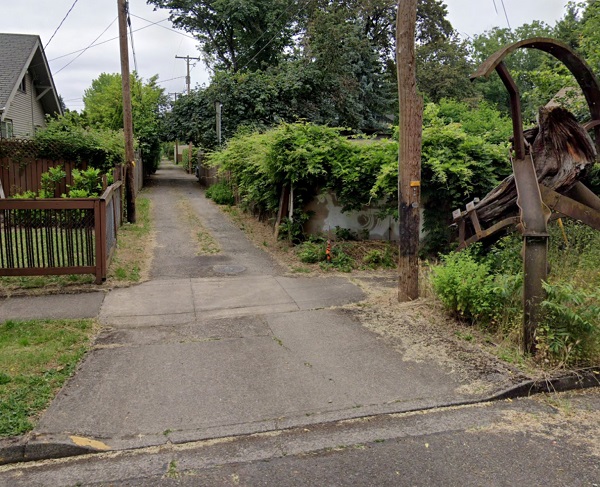The alleys of Jefferson Westside
3 min read
from the Jefferson Westside January 2023 eNews
As one of Eugene’s oldest neighborhoods, large parts of Jefferson Westside are laid out with alleys. The origin of the word alley is late Middle English, from Old French: alee “walking or passage”, from aller “to go”, from Latin: ambulare “to walk.”
Alleys are not streets, as they are too narrow and streets must meet a minimum width standard. Alleys were primarily designed as easements for utilities. Many of our beautiful treelined streets have no power poles because these run behind homes.
Originally, most lots encompassed all the land between a street and the alley. However, over the years many lots have been subdivided. There are also alley facing lots, an innovation of our special areas zones.
Some advantages of alley lots are that they are smaller and more affordable and place “eyes” on the alley that improve safety.
Who “Owns” an Alley?
Alleys are not owned by the city, but by the adjacent property owner – each property on either side of the alley owns to the middle. However, alleys have public easements, which means they must remain open and accessible to through traffic. Property owners do have trespass control of alleys just like other private property. That said, there are restrictions on uses and access via alleys, as with parking.
Repair and Maintenance
Property owners are responsible for the maintenance of alleys, which is why the condition of our alleys varies. As a baseline, an alley must support the weight and size of a firetruck. Property owners are thus faced with a conundrum. Better surfaces may encourage cut through vehicle and pedestrian traffic, which may bring unwanted activities.
Best Practices
For many, the primary concern around an alley is controlling access to your property, so consider a well-maintained and sturdy fence, 6-8 feet tall, with a secured access point. Lattice work extensions can be added to existing fences; the goal should be to make it difficult to scale. Bamboo, a hedge, or shrubs also can be effective.
Make sure your fence is graffiti free and your alley frontage is clear of trash and debris. Anything that displays disorder or lack of concern attracts unwanted activities. Keep weeds or plants trimmed. Dead weeds are also fire hazard (a neighbor recently lost a fence to an ill-placed campfire). Consider planting drought-tolerant low maintenance plants like rosemary (looks and smells great). Make your alley a clean, safe, and attractive space and it will encourage positive uses and behaviors.
For repairing an alley surface, such as filling large potholes, crushed rock is relatively inexpensive delivered and allows drainage. Keep in mind you want to make sure water does not travel into your yard.
Have an Alley Facing Lot?
For those who homes face an alley, an open, welcoming, but secure option is a sheep/hog panel fence. This sort of fence is relatively inexpensive and a DIY project that does not require a lot of skill/experience. Make sure your property is clean, well-maintained, and illuminated (motion-sensor lights are a good inexpensive option).
Alleys are an excellent feature of the JWN, and properly maintained, can provide great cut-through pedestrian access away from traffic, and easy access to backyards for delivery, construction, and storage.





